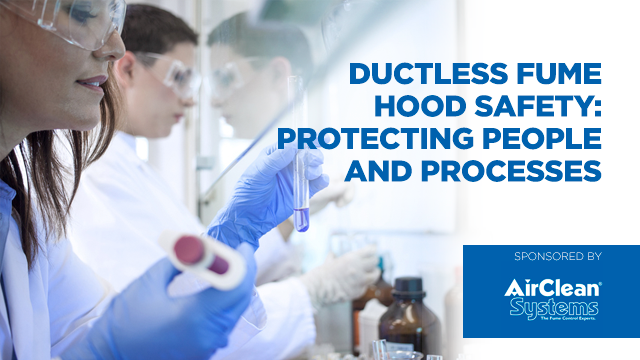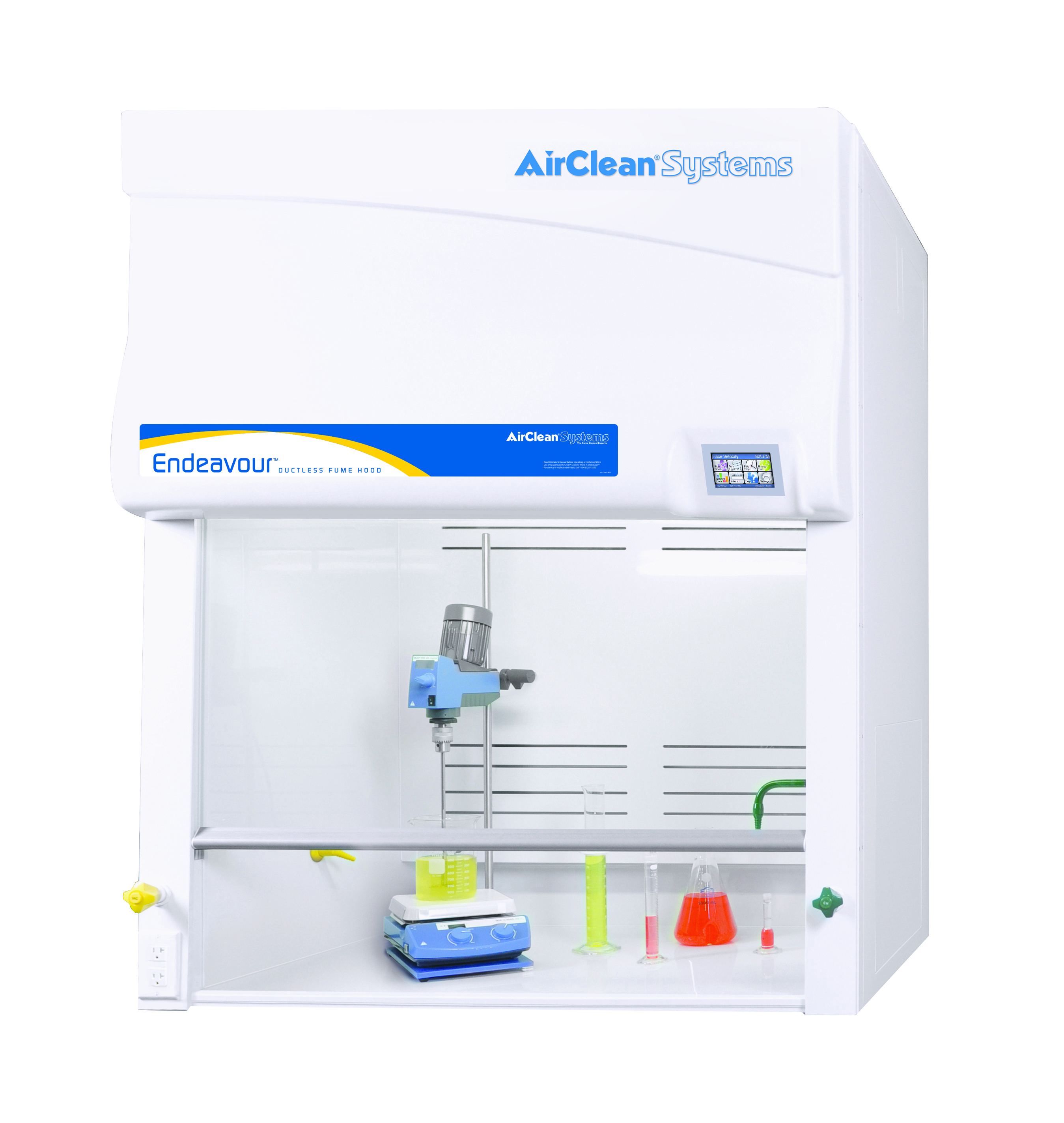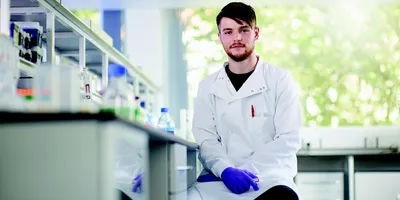
Introduction
 AirClean Ductless Chemical Workstationwww.aircleansystems.comA ductless fume hood is a self-contained laboratory enclosure that passes contaminated air through filters before returning the air directly back to the laboratory. Ductless fume hoods are not connected to an exhaust system, and they usually feature activated carbon filters. These systems are often selected for use in locations where outside ventilation cannot be achieved. In addition to removing a large amount of hazardous fumes, vapors, and particles from the laboratory, ductless fume hoods also result in energy and cost savings, offer mobility, and are convenient to use due to the lack of complex duct work and infrastructure requirements.
AirClean Ductless Chemical Workstationwww.aircleansystems.comA ductless fume hood is a self-contained laboratory enclosure that passes contaminated air through filters before returning the air directly back to the laboratory. Ductless fume hoods are not connected to an exhaust system, and they usually feature activated carbon filters. These systems are often selected for use in locations where outside ventilation cannot be achieved. In addition to removing a large amount of hazardous fumes, vapors, and particles from the laboratory, ductless fume hoods also result in energy and cost savings, offer mobility, and are convenient to use due to the lack of complex duct work and infrastructure requirements.
Ductless Fume Hood Safety
Considerations for protecting operators
 AirClean Endeavour Series Ductless Fume Hoodwww.aircleansystems.comThe primary function of a ductless fume hood is to protect the individuals working within it. Exposure to the fumes, vapors, and particles emanating from chemicals being used in experiments can result in injuries and, in extreme cases, death. Inward airflow must be within a specific range in order to safely remove hazardous materials; if airflow falls below a minimum value, these materials may flow out of the fume hood and pose hazards to laboratory staff. The effectiveness of a fume hood also relies on filters that are capable of removing the hazardous materials in question. It is essential that fume hood users have a means of monitoring both the airflow and filter conditions so that they may respond immediately if the fume hood’s safety is compromised. The customer and ductless manufacturer must work together to ensure proper selection of the correct hood too meet the laboratory application demand.
AirClean Endeavour Series Ductless Fume Hoodwww.aircleansystems.comThe primary function of a ductless fume hood is to protect the individuals working within it. Exposure to the fumes, vapors, and particles emanating from chemicals being used in experiments can result in injuries and, in extreme cases, death. Inward airflow must be within a specific range in order to safely remove hazardous materials; if airflow falls below a minimum value, these materials may flow out of the fume hood and pose hazards to laboratory staff. The effectiveness of a fume hood also relies on filters that are capable of removing the hazardous materials in question. It is essential that fume hood users have a means of monitoring both the airflow and filter conditions so that they may respond immediately if the fume hood’s safety is compromised. The customer and ductless manufacturer must work together to ensure proper selection of the correct hood too meet the laboratory application demand.
Considerations for protecting processes
 AirClean Ductless Balance Enclosurewww.aircleansystems.comIn addition to protecting users, a ductless fume hood can help to protect precious samples. Optimal airflow prevents samples from being contaminated by either the user or any materials floating around in the lab. The risk of background or cross-contamination of samples can also be avoided with appropriate filtration. Once again, a monitoring system is required to ensure that conditions in the fume hood remain safe for samples and experiments.
AirClean Ductless Balance Enclosurewww.aircleansystems.comIn addition to protecting users, a ductless fume hood can help to protect precious samples. Optimal airflow prevents samples from being contaminated by either the user or any materials floating around in the lab. The risk of background or cross-contamination of samples can also be avoided with appropriate filtration. Once again, a monitoring system is required to ensure that conditions in the fume hood remain safe for samples and experiments.
Features of a safe ductless fume hood
- Blower capable of maintaining face velocity at a safe opening per relevant standard. Face velocity is the pull at the opening of the fume hood that moves air from the laboratory room into the hood. The fume hood must maintain optimum face velocity for adequate fume containment.
- Vapor-proof illumination adequate for work area. Vapor-proof illuminators help meet safety requirements in applications involving flammable dust or vapor, while providing the operator with adequate lighting.
- Work area access. Users should have free and easy access to the fume hood’s work area through an adequate opening in order to set up and run experiments.
- Integral spill base. An integral spill base can effectively contain any accidental spills that may occur during chemical manipulation in the fume hood.
- Reliable method to monitor carbon filter bed saturation per ANSI Z9.5. This set of criteria for laboratory ventilation states that carbon filters must be monitored for saturation.
- Reliable airflow measurement device per 29 CFR 1910.1450. This standard states that fume hoods must maintain an airflow capable of drawing air from the laboratory and preventing or minimizing the escape of air contaminants into the laboratory.
- Constructed from application appropriate materials to prevent hood deterioration. To ensure fume hood longevity, the interior materials must resist attack from the acid fumes, vapors, and the range of temperatures they will be exposed to.
- Rear baffle to promote even airflow. Baffles are moveable partitions used to create slotted openings along the back of the fume hood that help to maintain even airflow.
Safety Tips
Selecting a ductless fume hood with safety features is key, but laboratory staff must also be trained to use the fume hood correctly. The Occupational Health and Safety Administration offers the following tips for staying safe while working with a fume hood:
- Make sure that you understand how the fume hood works and are trained to use it properly
- If you are unsure about the hazards of any of the chemicals you are working with, refer to the appropriate Safety Data Sheet
- Ensure that the fume hood is on
- Open the sash to the proper operating level, which is usually indicated by arrows on the frame
- Make sure that the air flow is within the required range
- Never allow your head to enter the plane of the hood opening
- Always wear appropriate eye protection
- Make sure that nothing blocks the airflow through the baffles or the baffle exhaust slots
- Keep large equipment elevated at least two inches off the base of the fume hood
- Keep all materials inside the hood at least six inches away from the sash opening
- When not working in the hood, keep the sash closed
- Do not permanently store any chemicals inside the hood
Conclusion
While conventional fume hoods are still the most common choice for ventilating hazardous airborne materials from the laboratory, ductless fume hoods are gaining in popularity. Their appeal is related to their associated cost and energy savings, and convenience. However, when it comes to lab work, safety comes first. It is essential that you consider the features of a safe ductless fume hood prior to purchasing a system for your lab. With these features in place, and with properly trained staff, a ductless fume hoods is well-equipped to protect both the people and the processes in your lab from potential injury and contamination, respectively.









